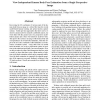Free Online Productivity Tools
i2Speak
i2Symbol
i2OCR
iTex2Img
iWeb2Print
iWeb2Shot
i2Type
iPdf2Split
iPdf2Merge
i2Bopomofo
i2Arabic
i2Style
i2Image
i2PDF
iLatex2Rtf
Sci2ools
CVPR
2004
IEEE
2004
IEEE
View Independent Human Body Pose Estimation from a Single Perspective Image
Recovering the 3D coordinates of various joints of the human body from an image is a critical first step for several model-based human tracking and optical motion capture systems. Unlike previous approaches that have used a restrictive camera model or assumed a calibrated camera, our work deals with the general case of a perspective uncalibrated camera and is thus well suited for archived video. The input to the system is an image of the human body and correspondences of several body landmarks, while the output is the set of 3D coordinates of the landmarks in a bodycentric coordinate system. Using ideas from 3D model based invariants, we set up a polynomial system of equations in the unknown head pitch, yaw and roll angles. If we are able to make the often-valid assumption that torso twist is small, we show that there exists a finite number of solutions to the head-orientation which can be computed readily. Once the head orientation is computed, the epipolar geometry of the camera is ...
Computer Vision | CVPR 2004 | Human Body | Model-based Human Tracking | Perspective Uncalibrated Camera | Restrictive Camera Model | Unknown Head Pitch |
| Added | 12 Oct 2009 |
| Updated | 12 Oct 2009 |
| Type | Conference |
| Year | 2004 |
| Where | CVPR |
| Authors | Vasu Parameswaran, Rama Chellappa |
Comments (0)

